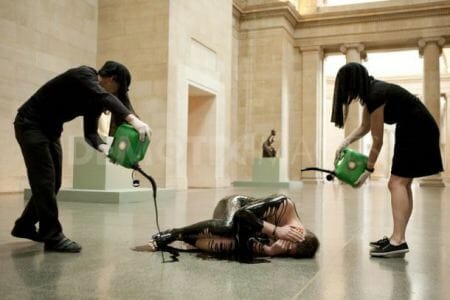
We often get asked: if we want the arts to be free from sponsorship by climate-wrecking oil companies, where’s the money going to come from? And aren’t we just going to push art institutions towards other corporate sponsors (arms dealers, banks) with tarnished reputations to polish?
My immediate answer to this question is in the timing. Right now, to act on climate change and make sure that all of us have a chance to a safe planet to live on, it’s important to remove oil’s influence out of arts, politics, research, you name it. And yet, the question is clearly wider than this. What follows is a set of provisional reflections spurred by one very inspiring event and by the Tate & BP secrets – I’d love to hear what my readers and colleagues think!
At the end of January, I spent the day discussing funding and values with people from across the arts sector at Take The Money And Run. Among the incredible variety of contributions, and while thinking through the Tate/BP secrets revealed earlier that week, it became clearer and clearer to me that we need to work towards culture beyond oil and beyond corporations.
Here’s why.
Austerity is not inevitable
Much of the discussion around funding problems (including sponsorship) is framed in the context of government cuts. Arts Council England had to cut 30% of its budget between 2011-2015. Many vital organisations lost their funding. As professor Jen Harvie (Queen Mary University London) pointed out, an even larger cut to arts funding comes through local authority funding: when forced to slash budgets, local authorities see museums and galleries as non-essential services, easier to do without.
But the cuts are not just context. They’re not an inevitability.
Like David Cross (University of the Arts London) said,
Lots of British things used to be national. British Coal. British Gas. British Petroleum. British art isn’t yet privatised.
While privatisation defined the reality we’re living in, we can shift the possible again.
Making artists into entrepreneurs
The current dominant ideology of neoliberalism – i.e. organising politics and economy around large profit-making corporations and financial elites – makes alternative futures unthinkable, as the people behind the Kilburn Manifesto point out. This is starkly, very practically visible in the art context. Jen Harvie again:
Neoliberal ideology limits what art can be.
Austerity in arts funding starves the more experimental, the more challenging, the more diverse in culture – anything that won’t buy corporate sponsors the publicity they desire. Someone asked Liberate Tate, “Would you ever take money from an oil company?” The answer: “No. And we never have to worry about the possibility. BP aren’t interested in funding performance art interventions, they want the prestige of Tate and Royal Opera House.”
Tate in its turn was refusing to reveal information about BP funding for reasons of “commercial interest”. The gallery argued in court that revealing funding amounts would lead to providing a ‘price list’ to potential sponsors. How much can Tate’s credibility be bought for? Not that much, it turns out. Cambridge University is refusing to disclose details of fossil fuel sponsorship for the same reason of “commercial interest”. As Alice Bell argues, this frames the institution as primarily a money-making enterprise. Cambridge and Tate both argue that they sell their product (cultural kudos, research, impressive venues, elite connections) for a secret price to the highest bidder. Public artwork and the public benefits of research are a totally separate byproduct, from the point of view of sponsorship relationships.
Austerity (or neoliberal ideology to be precise) encourages the artist or arts organisation to think and act as an entrepreneur, selling culture – whether the actual works or the associated credibility – on the market.
Shifting the possible: public investment
Our job, then, is to make it possible to imagine our world (our energy, our culture) beyond neoliberalism.
First, that means not talking of austerity as inevitable context. Like Judith Knight (Artsadmin and WhatNext) said,
Let’s not talk about philanthropy without talking about public investment.
Artists and arts organisations can work together to protect – and demand better – public funding for culture.
Allow me a bit of a digression into energy politics. As part of the Kilburn Manifesto, we’ve been working out what an energy system beyond neoliberalism might look like. How do we address our society’s needs for energy in a democratically accountable way, making sure people can afford the energy they need, while addressing the climate crisis? The answers we find around the world are a mix of co-operatives, commons, municipal and public investment. But inevitably these answers involve changing our concepts, too.
So I would like us to talk about what art beyond neoliberalism looks like. What kind of funding models do we want to see? How and what would it prioritise?
Art is powerful
Judith Knight again:
The powerful know the power of art, of things that inspire us
That’s why BP and political elites try to harness art through sponsorship. And that’s also why political art intervention works.
So: let’s not forget that art has power. Let’s think about what art beyond austerity looks like. And let’s challenge austerity when we challenge corporate ‘artwash’.
With thanks to Live Art Development Agency, Home Live Art, ArtsAdmin, and everyone who came along to Take The Money And Run. Watch a 5-minute trailer or 40-minute documentary from the event here, or read writer Mary Paterson’s response.
For more readings on ethics, sponsorship, and making art, see our study room guide.